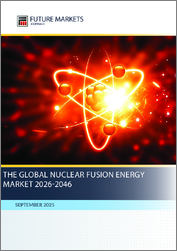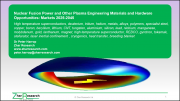
|
시장보고서
상품코드
1429254
핵융합 시장 : 현재 분석 및 예측(2030-2040년)Nuclear Fusion Market: Current Analysis and Forecast (2030-2040) |
||||||
핵융합 시장은 원자력 에너지에 대한 정부 자금 증가로 CAGR 약 6%의 안정적인 성장이 예상됩니다. 게다가 지속가능한 에너지원에 대한 요구 증가, 기후 변화 및 화석연료 매장량의 고갈에 대한 우려가 높아짐에 따라 핵융합은 배출물이 없는 사실상 무한한 에너지 공급을 제공하여 세계의 에너지 수요에 대응할 가능성이 있기 때문에 주류로 뛰어 나왔습니다. 게다가, 기술의 진보는 핵융합의 실현가능성과 상업적 실행가능성을 현저하게 향상시키고 있습니다. 플라즈마 감금, 초전도 자석, 핵융합로의 설계 혁신은 보다 효율적이고 컴팩트한 융합로의 개발로 이어졌습니다. 이러한 기술적 진보는 투자자의 신뢰를 높이고 이 분야에 많은 돈을 끌어들입니다. 예를 들어, 2022년 12월, 미국 에너지부에서 핵융합 과학에서 중요한 과학적 진보가 발표되었습니다. 놀랍게도, 핵융합 반응을 일으키는데 필요한 에너지량을 초과하는 에너지가 얻어졌고, 획기적인 결과가 나타났습니다.
기술에 근거하여, 시장은 관성 가둠 및 자기 가둠으로 이분됩니다. 자기장 가둠은 일반적으로 가장 효율적이며 세계 핵융합에 매우 선호되는 기술로 간주됩니다. 자기장 가둠에 대한 기울기의 주요 요인은 자기장 가둠이 핵융합에 필요한 조건을 달성하는 데 필수적인 장기간 지속되는 플라즈마 가둠을 허용하기 때문입니다. 관성 가둠은 일반적으로 짧은 시간의 펄스를 필요로 하는 반면, 자기 가둠은 레이저 융합과 같은 다른 응용에 적합합니다. 게다가 토카막과 스텔라레이터와 같은 자기 가둠 기술은 확장성이 높고 보다 크고 강력한 장치로 발전할 수 있습니다. 이러한 확장성은 장기적으로 더 많은 양의 핵융합 에너지를 생산할 수 있게 합니다. 이 외에도 자기장 가둠 방식은 플라즈마의 모양과 안정성을 보다 잘 제어할 수 있어 보다 효율적인 원자로 설계가 가능해집니다. 이것은 핵융합 반응을 제어하고 에너지 출력을 극대화하는 능력을 증가시킵니다.
연료를 기반으로 시장은 중수소-삼중수소, 중수소, 중수소 헬륨 3, 양성자 붕소로 구분됩니다. 현재 세계적으로 핵융합에 가장 효율적이고 매우 선호되는 연료는 중수소-삼중수소(DT) 연료의 조합인 것으로 보입니다. 수소의 동위 원소인 중수소는 해수에서 쉽게 얻을 수 있기 때문에 풍부하게 존재합니다. 한편, 트리튬은 자연계에 존재하지 않기 때문에 핵융합로에서 생성 또는 증식시켜야 합니다. 그러나, 트리튬은 상대적으로 풍부한 리튬으로부터 생성될 수 있습니다. 또한, DT 융합은 핵융합을 달성하는데 필요한 온도가 가장 낮기 때문에 다른 연료의 조합에 비해 핵융합의 달성과 유지가 비교적 용이합니다. 이 외에도 DT 핵융합은 다른 연료 조합에 비해 단위 질량당 에너지 출력이 가장 높습니다. 이 높은 에너지 출력은 상용 핵융합 발전의 연료로 선호되는 원인이 되었습니다.
핵융합 시장 도입에 대한 이해를 높이기 위해 시장은 북미(미국, 캐나다, 기타 북미), 유럽(독일, 영국, 프랑스, 스페인, 이탈리아, 기타 유럽), 아시아태평양(중국, 일본, 인도, 기타 아시아태평양), 세계 기타 지역에서 세계의 존재를 기반으로 분석됩니다. 유럽은 놀라운 발전을 이루고 있으며 핵융합 발전의 영역에서 전면 러너로 널리 인정받고 있습니다. 이 분야에서 유럽의 진보에는 수많은 요인이 기여하고 있으며, 그 두드러진 예 중 하나가 국제 열핵융합실험로(ITER)입니다. ITER 프로젝트의 호스트 국가로서 유럽은 프랑스에 있는 세계 최대의 핵융합 실험 시설을 자랑합니다. 이 협력적인 시도에는 유럽의 여러 국가를 포함한 35개국이 참여하고 있으며, 핵융합 연구의 리더로서 유럽의 지위를 대폭 강화하고 있습니다. 또한 유럽은 핵융합 에너지의 발전에 힘쓰는 연구 기관과 대학 간의 견고한 파트너십을 키워왔습니다. 유럽 핵융합개발협정(EFDA)과 EUROfusion 컨소시엄은 이러한 협력관계의 대표예이며, 핵융합 에너지의 발전을 위해 과학자, 기술자, 자원을 결집하고 있습니다. 게다가 영국의 조인트 유럽인 토러스(JET)와 독일의 벤델슈타인 7-X 시설과 같은 시설은 핵융합 연구에서 유럽의 리더십에서 매우 중요한 역할을 합니다.
목차
제1장 시장 서문
- 시장의 정의
- 주요 목표
- 이해 관계자
- 제한 사항
제2장 조사 방법 또는 전제
- 조사 과정
- 조사 방법
- 응답자 프로파일
제3장 시장 요약
제4장 주요 요약
제5장 COVID-19가 핵융합 시장에 미치는 영향
제6장 핵융합 시장 수익(2020-2030년)
제7장 기술별 시장 인사이트
- 관성 가둠
- 자기 가둠
제8장 연료별 시장 인사이트
- 중수소 트리튬
- 중수소
- 중수소 헬륨 3
- 양성자 붕소
제9장 지역별 시장 인사이트
- 북미
- 미국
- 캐나다
- 기타 북미
- 유럽
- 독일
- 영국
- 프랑스
- 이탈리아
- 스페인
- 기타 유럽
- 아시아태평양
- 중국
- 인도
- 일본
- 한국
- 기타 아시아태평양
- 세계 기타 지역
제10장 핵융합 시장 역학
- 시장 성장 촉진요인
- 시장의 과제
- 영향 분석
제11장 핵융합 시장 기회
제12장 핵융합 시장 동향
제13장 수요측 및 공급측 분석
- 수요측 분석
- 공급측 분석
제14장 밸류체인 분석
제15장 경쟁 시나리오
- 경쟁 구도
- Porter's Five Forces 분석
제16장 기업 프로파일
- First Light Fusion Ltd
- Zap Energy Inc.
- Renaissance Fusion
- Lockheed Martin Corporation
- TAE Technologies, Inc.
- Commonwealth Fusion Systems
- Marvel Fusion GmbH
- General Fusion
- KYOTO FUSIONEERING LTD.
- Tokamak Energy Ltd
제17장 면책사항
AJY 24.03.04Nuclear fusion, in the context of physics and energy production, refers to a process in which two or more atomic nuclei join together to form a new, heavier nucleus. This merging of atomic nuclei releases an immense amount of energy. It is the fundamental mechanism by which stars, including our Sun, generate heat and light. Nuclear fusion has the potential to revolutionize energy production due to numerous benefits. It produces vast amounts of energy, is virtually limitless in terms of fuel availability, and generates significantly less radioactive waste compared to nuclear fission (the splitting of heavy atomic nuclei). Furthermore, fusion reactions do not release greenhouse gases or contribute to the long-lived radioactive waste associated with conventional power sources.
The Nuclear Fusion Market is expected to grow at a steady CAGR of around 6% owing to the increased government funding for nuclear energy. Furthermore, the increasing need for sustainable energy sources and rising concerns over climate change and depleting fossil fuel reserves have catapulted nuclear fusion into the mainstream due to its potential to provide an emission-free, virtually limitless energy supply, addressing global energy demands. Moreover, advancements in technology have significantly enhanced the feasibility and commercial viability of nuclear fusion. Innovations in plasma confinement, superconducting magnets, and fusion reactor designs have led to the development of more efficient and compact fusion reactors. These technological advancements have bolstered investor confidence and attracted substantial funding to the sector. For instance, in December 2022, a significant scientific advancement in nuclear fusion science was announced by the U.S. Department of Energy. Remarkably, the fusion reaction yielded more energy than the amount required to initiate it, marking a groundbreaking achievement.
Based on technology, the market is bifurcated into inertial confinement and magnetic confinement. Magnetic confinement is generally considered the most efficient and highly preferred technology for global nuclear fusion. The primary factor responsible for this inclination towards magnetic confinement is that, they allow for sustained plasma confinement over longer durations, which is essential for achieving the conditions required for nuclear fusion. While inertial confinement typically involves short-duration pulses that are more suitable for other applications, such as laser fusion. Furthermore, magnetic confinement technologies, such as tokamaks and stellarators, are more scalable and can be developed into larger and more powerful devices. This scalability enables the production of more significant amounts of fusion energy in the long run. In addition to this, The magnetic confinement approach provides better control over the shape and stability of the plasma, allowing for more efficient reactor designs. This enhances the ability to control fusion reactions and maximize energy output.
Based on fuels, the market is segmented into deuterium-tritium, deuterium, deuterium helium3, and proton boron. The most efficient and highly preferred fuel for nuclear fusion globally currently seems to be the deuterium-tritium (D-T) fuel combination. Primary factors that are responsible for this include abundance, where deuterium, an isotope of hydrogen, is readily available in seawater, making it abundant. Tritium, on the other hand, is not naturally occurring and needs to be produced or bred within the fusion reactor. However, tritium can be bred from lithium, which is also relatively abundant. Furthermore, D-T fusion has the lowest temperature requirements for achieving fusion, making it relatively easier to achieve and sustain compared to other fuel combinations. In addition to this, D-T fusion offers the highest energy output per unit mass compared to other fuel combinations. This higher energy output contributes to its preference as a fuel for commercial fusion power generation.
For a better understanding of the market adoption of nuclear fusion, the market is analyzed based on its worldwide presence in countries such as North America (The U.S., Canada, and the Rest of North America), Europe (Germany, The U.K., France, Spain, Italy, Rest of Europe), Asia-Pacific (China, Japan, India, Rest of Asia-Pacific), Rest of World. Europe has made remarkable strides and is widely recognized as a frontrunner in the realm of nuclear fusion power generation. Numerous factors have contributed to Europe's progress in this domain, with one notable example being the International Thermonuclear Experimental Reactor (ITER). As the host of the ITER project, Europe boasts the world's largest experimental fusion facility, situated in France. This collaborative endeavor involves 35 countries, including several European nations, and has significantly bolstered Europe's position as a leader in nuclear fusion research. Moreover, Europe has fostered robust partnerships among research institutions and universities dedicated to advancing fusion energy. The European Fusion Development Agreement (EFDA) and the EUROfusion consortium are prime illustrations of such collaborations, uniting scientists, engineers, and resources for the advancement of fusion energy. Additionally, Europe's research infrastructure for nuclear fusion is firmly established, with facilities like the Joint European Torus (JET) in the United Kingdom and the Wendelstein 7-X facility in Germany playing pivotal roles in Europe's leadership in fusion research.
Some of the major players operating in the market include First Light Fusion Ltd; Zap Energy Inc.; Renaissance Fusion; Lockheed Martin Corporation; TAE Technologies, Inc.; Commonwealth Fusion Systems; Marvel Fusion GmbH; General Fusion; KYOTO FUSIONEERING LTD.; and Tokamak Energy Ltd
TABLE OF CONTENTS
1 MARKET INTRODUCTION
- 1.1. Market Definitions
- 1.2. Main Objective
- 1.3. Stakeholders
- 1.4. Limitation
2 RESEARCH METHODOLOGY OR ASSUMPTION
- 2.1. Research Process of the Nuclear Fusion Market
- 2.2. Research Methodology of the Nuclear Fusion Market
- 2.3. Respondent Profile
3 MARKET SYNOPSIS
4 EXECUTIVE SUMMARY
5 IMPACT OF COVID-19 ON THE NUCLEAR FUSION MARKET
6 NUCLEAR FUSION MARKET REVENUE (USD BN), 2020-2030F.
7 MARKET INSIGHTS BY TECHNOLOGY
- 7.1. Inertial Confinement
- 7.2. Magnetic Confinement
8 MARKET INSIGHTS BY FUELS
- 8.1. Deuterium tritium
- 8.2. Deuterium
- 8.3. Deuterium Helium3
- 8.4. Proton Boron
9 MARKET INSIGHTS BY REGION
- 9.1. North America
- 9.1.1. The U.S.
- 9.1.2. Canada
- 9.1.3. Rest of North America
- 9.2. Europe
- 9.2.1. Germany
- 9.2.2. The U.K.
- 9.2.3. France
- 9.2.4. Italy
- 9.2.5. Spain
- 9.2.6. Rest of Europe
- 9.3. Asia-Pacific
- 9.3.1. China
- 9.3.2. India
- 9.3.3. Japan
- 9.3.4. South Korea
- 9.3.5. Rest of Asia-Pacific
- 9.4. Rest of the World
10 NUCLEAR FUSION MARKET DYNAMICS
- 10.1. Market Drivers
- 10.2. Market Challenges
- 10.3. Impact Analysis
11 NUCLEAR FUSION MARKET OPPORTUNITIES
12 NUCLEAR FUSION MARKET TRENDS
13 DEMAND AND SUPPLY-SIDE ANALYSIS
- 13.1. Demand Side Analysis
- 13.2. Supply Side Analysis
14 VALUE CHAIN ANALYSIS
15 COMPETITIVE SCENARIO
- 15.1. Competitive Landscape
- 15.1.1. Porters Fiver Forces Analysis
16 COMPANY PROFILED
- 16.1. First Light Fusion Ltd
- 16.2. Zap Energy Inc.
- 16.3. Renaissance Fusion
- 16.4. Lockheed Martin Corporation
- 16.5. TAE Technologies, Inc.
- 16.6. Commonwealth Fusion Systems
- 16.7. Marvel Fusion GmbH
- 16.8. General Fusion
- 16.9. KYOTO FUSIONEERING LTD.
- 16.10. Tokamak Energy Ltd


















